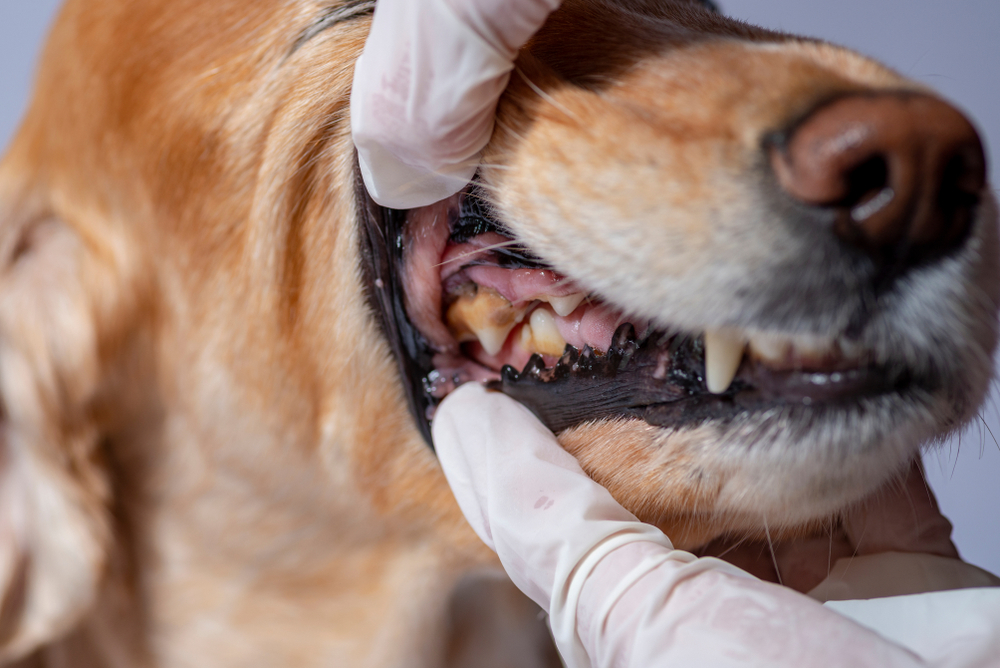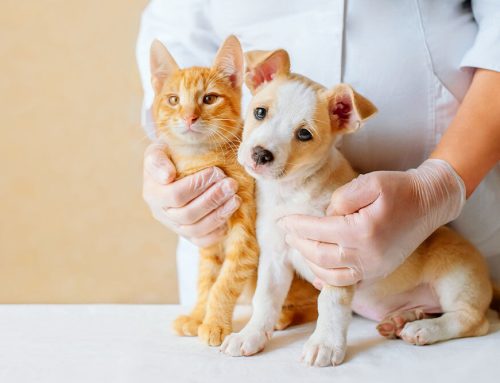Similar to people, pets who go a long period without dental care develop plaque and bacterial buildup on their teeth and below the gumline, leading to a deterioration in their overall oral health. Most pets start to show signs of dental disease around age 3, which will progress over time and eventually cause undue pain and suffering if not addressed.
The Tender Touch Animal Hospital team knows that many pet owners underestimate the importance of pet dental care, so we’re taking advantage of National Pet Dental Health Month to provide an overview of dental health, dental disease, and the importance of regular pet dental care.
Dog dental disease
Dogs typically suffer from periodontal disease caused by excessive plaque and tartar, and bacteria that take advantage of the situation. Harmful oral bacteria can proliferate and invade below the gumline, causing classic early gingivitis signs, including bleeding and redness. As the disease progresses, the bacteria attack tooth roots, tooth attachments, and the jawbone, resulting in pain and loose or missing teeth. Tooth fractures from inappropriate chewing or trauma also can set the stage for dental infections in otherwise healthy mouths.
Dental disease signs in dogs include:
- Bad breath
- Red, swollen, or bleeding gums
- Drooling
- Dropping food or chewing on one side
- Pawing at the mouth
- Swelling of the face
- Reduced desire to play or chew
- Behavior changes—may become withdrawn, needy, or irritable
Small-breed dogs and those with short noses often have crowded teeth and abnormal bites that predispose them to faster plaque and tartar accumulation than larger dogs. Disease can progress quickly in these pets, and they often need more overall dental care than other dogs.
Cat dental disease
Most cats develop periodontal disease more slowly and later in life than dogs, but may show signs by age 4. Cats also can develop unique dental problems that may be unrelated to tartar buildup, or may be caused by an immune system overreaction to minuscule plaque and bacteria. Cats need annual dental exams starting from an early age, because dental conditions can take hold at any time. Features unique to cat dental disease include:
- Stomatitis — This causes widespread inflammation of the gums and mucous membranes inside the mouth, and is thought to be related to the immune system or infectious diseases.
- Resorptive lesions — Many cats develop feline odontoclastic resorptive lesions (FORL), often symmetrically. Affected teeth dissolve slowly over time from the inside out, which leads to weak spots and nerve exposure that can be extremely painful.
Signs of cat periodontal disease, stomatitis, and FORLs include:
- Drooling
- Jaw chattering
- Preference for soft food
- Reduced appetite or refusal to eat despite showing interest in food
- Red, swollen, ulcerated mouth tissues
- Red spots on teeth near the gumline

How dental health affects the whole pet
If you have ever experienced a toothache, you know the effect debilitating dental issues can have on your daily life. Pets with dental disease and one or more painful teeth have pain every time they eat or pick up an object, which quickly results in a reduced quality of life. Your pet may lose interest in food or play, become more clingy, or spend more time alone.
Severe, untreated dental disease can allow bacteria into the bloodstream, from where they can travel to major organs and cause permanent heart, liver, or kidney damage. Providing regular care before dental disease advances to this stage can keep your pet’s mouth healthy, prevent chronic pain, and effectively extend their life.
Professional pet dental cleanings
Professional dental cleanings are necessary to treat pets who already have significant dental disease and discomfort, and they also can be used to prevent problems in pets with relatively healthy teeth. Humans visit the dentist twice per year, and pets need the same deep cleaning people get from their human hygienist. To provide pets with a thorough cleaning, examination, X-rays to evaluate the tooth roots, and all necessary extractions or other treatments, we provide dentistry exclusively under general anesthesia. This keeps pets safe through the procedure, reduces stress, and ensures they do not feel any pain.
Our veterinary team can evaluate your pet’s teeth to determine if a professional dental cleaning is necessary, and will determine, based on your pet’s species, age, breed, and individual genetics, how frequently they should return for additional cleanings.
Pet dental home care
Dental home care is essential to keep your pet’s teeth healthy between professional cleanings and to slow disease progression. Daily toothbrushing is the gold standard for home care, and can be accomplished with a slow, positive introduction. If your pet does not tolerate brushing, our team can recommend safe, effective products to help slow plaque and tartar buildup and reduce the “bad” bacteria population in your pet’s mouth.\
Our Tender Touch Animal Hospital team recommends semi-annual wellness examinations, during which we will assess your pet’s teeth and develop an individualized care plan to improve and sustain their oral health—leading to a happier, healthier, longer-lived pet. Contact us to schedule a dental consultation, your pet’s next professional dental cleaning, or if you have questions about your pet’s oral health care plan.







Leave A Comment